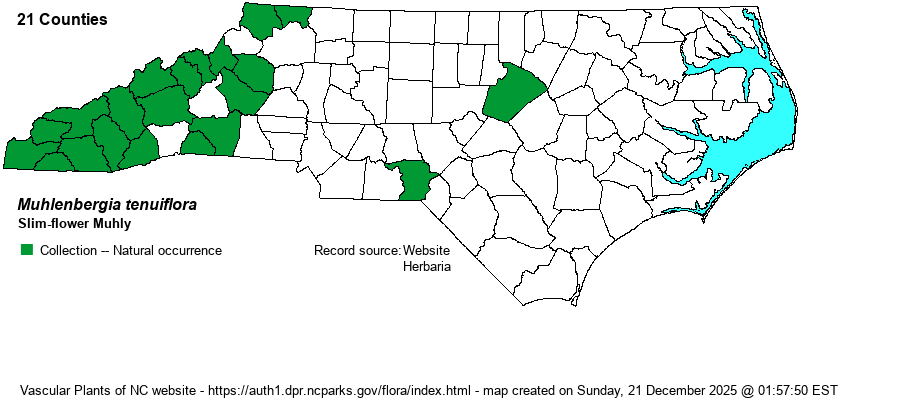| Author | (Willdenow) Britton, Sterns, & Poggenburg | |
| Distribution | Mountains and uppermost Piedmont; disjunct to Richmond (2 widely separated ledgey slopes beside the Pee Dee River) and Wake (Umstead State Park) counties in the lower Piedmont. Ought to occur in other Piedmont counties, as in VA it is found over much of that province.
NH to WI and NE, south to GA, MS, and OK. | |
| Abundance | Frequent in the Mountains; uncommon in the foothills, and very rare east to the Fall Line region. | |
| Habitat | Rocky to moist/rich deciduous woodlands and forests, and openings in them; on 2 riverside ledgey slopes in Richmond County; "firelane" in Umstead SP (Wake County). Soils are usually circumneutral. | |
| Phenology | Flowering and fruiting August-October. | |
| Identification | This graceful grass grows 1-2.5 feet tall, rarely to 3 feet, and with a long, slender inflorescence. The spikelets are generally appressed to the stalk. In overall gestalt, it most resembles M. sobolifera, but the latter differs in lacking an awn on the lemma (occasionally present but if so under 1 mm long) vs. an awn up to 12 mm long. | |
| Taxonomic Comments | None
In NC the genus Muhlenbergia assumes 2 very different forms of inflorescences: very open and airy or narrow and elongate, with short branches. In both cases, attention to details of the key is important, along with a dissecting scope. Once learned, however, most muhlys can be identified on sight in the field. Spikelets contain a single floret (rarely 2-3). | |
| Other Common Name(s) | Slender Muhly, Slender Satin-grass | |
| State Rank | S3? [S3] | |
| Global Rank | G5 | |
| State Status | | |
| US Status | | |
| USACE-agcp | FACU link |
| USACE-emp | FACU link |

